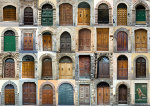Buying and Renovating: The Charm of Italian Countryside Homes
Enzo Ricci, Wednesday, 10 January 2024

IIn the idyllic landscapes of Italy, where time seems to follow a different pace, the number of traditional rural homes remains remarkably stable. These houses, hidden among rolling hills and ancient olive trees, are a testament to Italian history and culture. What makes one curious is that despite their sometimes dilapidated state, these homes can still demand a considerable price. But why is that? Let's dive together into the charming world of these rural Italian treasures.
What Determines the Price?
A client of mine once fell in love with an old house, hidden under nature, with a view that takes your breath away. But here we encounter a unique challenge of the Italian countryside: while you have a lot of freedom to renovate inside, the exterior of the house is often untouchable. The historical facades and traditional architecture are protected and must remain unchanged, which means that expansions or external changes are usually not allowed.
Renovation is thus a delicate balance between preserving this historical charm and adapting to modern conveniences. This makes the 'geometra' – a mix of building master, civil engineer, and architect – an indispensable link in this process. The geometra not only coordinates the work but also takes care of the necessary permits, with the costs amounting to about 14-16% of the construction sum. For more insight into this crucial role, see my earlier article: .
Building Permits and Internal Adjustments:
Within the walls of your future Italian home, you can make many adjustments - from installing larger windows to a complete redesign. This offers the freedom to put your own stamp on the interior while preserving the timeless beauty of the exterior. And who knows, you might even find a way to add an elegant swimming pool to your piece of paradise.
Our comprehensive guide is the perfect companion if you are considering moving to Italy or are already living there. Learn all about buying a house, mastering the Italian language, finding a job, experiencing the culture and discovering tourist attractions. With this guide, you'll have all the information you need to live successfully in Italy. Read on now to discover it all!

IIn the idyllic landscapes of Italy, where time seems to follow a different pace, the number of traditional rural homes remains remarkably stable. These houses, hidden among rolling hills and ancient olive trees, are a testament to Italian history and culture. What makes one curious is that despite their sometimes dilapidated state, these homes can still demand a considerable price. But why is that? Let's dive together into the charming world of these rural Italian treasures.
What Determines the Price?
- The View: Looking out from your window over vineyards or historic villages undoubtedly adds value.
- Accessibility: The distance to airports and highways is crucial, but also a factor of peace and quiet.
- Location: The closer to bustling cities or the calming sea, the more desirable the property.
- Architectural and Historical Value: Each house tells its own story, rooted in Italian culture.
- Noise Pollution and Plot Size: Important considerations for the quality of life.
A client of mine once fell in love with an old house, hidden under nature, with a view that takes your breath away. But here we encounter a unique challenge of the Italian countryside: while you have a lot of freedom to renovate inside, the exterior of the house is often untouchable. The historical facades and traditional architecture are protected and must remain unchanged, which means that expansions or external changes are usually not allowed.
Renovation is thus a delicate balance between preserving this historical charm and adapting to modern conveniences. This makes the 'geometra' – a mix of building master, civil engineer, and architect – an indispensable link in this process. The geometra not only coordinates the work but also takes care of the necessary permits, with the costs amounting to about 14-16% of the construction sum. For more insight into this crucial role, see my earlier article: .
Building Permits and Internal Adjustments:
Within the walls of your future Italian home, you can make many adjustments - from installing larger windows to a complete redesign. This offers the freedom to put your own stamp on the interior while preserving the timeless beauty of the exterior. And who knows, you might even find a way to add an elegant swimming pool to your piece of paradise.
Links
Our comprehensive guide is the perfect companion if you are considering moving to Italy or are already living there. Learn all about buying a house, mastering the Italian language, finding a job, experiencing the culture and discovering tourist attractions. With this guide, you'll have all the information you need to live successfully in Italy. Read on now to discover it all!

All types of Italian property for sale by private sellers and estate agents. Find your perfect houses, farmhouses or apartment in all regions of Italy including Liguria, Tuscany, Umbria and Marche.
 Useful tips when applying for a mortgage in Italy. Did you know that, as a non-resident, it’s not so easy to get a mortgage for a renovation object, or
a house somewhere in the countryside? Which Italian bank should you choose for your mortgage?
Useful tips when applying for a mortgage in Italy. Did you know that, as a non-resident, it’s not so easy to get a mortgage for a renovation object, or
a house somewhere in the countryside? Which Italian bank should you choose for your mortgage?
More articles